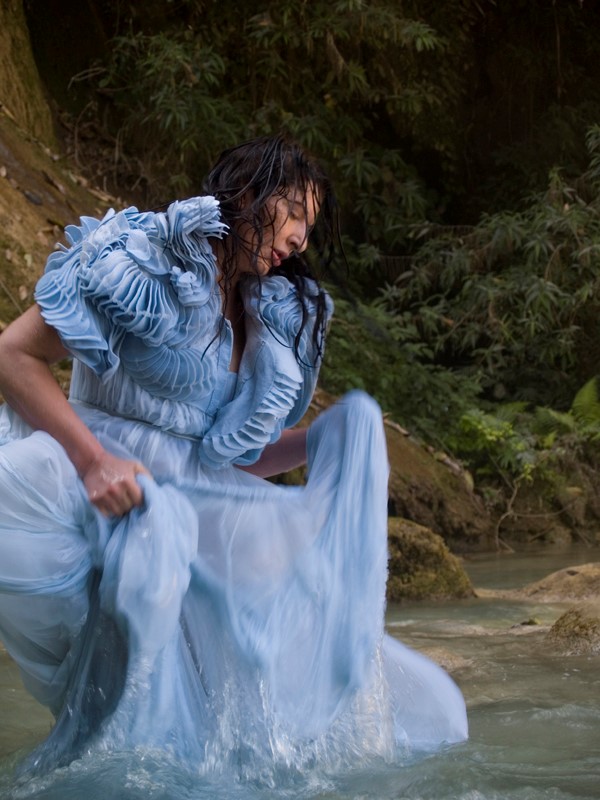In recent years, following shows at the Guggenheim in 2005 and at MoMA in 2010 (where she staged the 700-hour performance piece, The Artist is Present), Marina Abramović has become the international face of performance art. She has brought the
Organised around a regular pattern: in this column each interviewee picks the picture that illustrates their interview, answers six questions that are the same for all contributors and then two more that are designed specifically for them.
In recent years, following shows at the Guggenheim in 2005 and at MoMA in 2010 (where she staged the 700-hour performance piece, The Artist is Present), Marina Abramović has become the international face of performance art. She has brought the practice closer to the fashion world through her collaborations with her close friend, Givenchy’s artistic director Riccardo Tisci.
How would you connect fashion to elegance?
There is a big difference between fashion and elegance. You can be a fashion victim and not necessarily be elegant. Elegance is something that is hard to learn. You have to have that within yourself... the ability to put pieces of clothing together which work best for you, and create an effortless, elegant look.
What is the role of history and art history in your conception of fashion?
Fashion feeds on art and constantly revisits different periods in history and art history. It is up to the talent of the designer to determine how they can bring historical ideas into contemporary looks.
Would you describe fashion as a language and a discourse, as Barthes did?
Fashion plays an important role in all cultures and it is definitely a language. Recently, I looked at the film Wim Wenders made about Yohji Yamamoto. He said that in the past if somebody went to sleep and put their clothes on a hanger, just by looking at the hanger you would know if the person is a cook, gardener, artist, writer etc. The clothes exactly described the profession. Now it's not like that anymore. Fashion makes the language, so that you can be whatever you want.
The word 'intellectual' was coined in a time of great political distress. Does fashion have a political role? And in which way?
Fashion definitely has a political role. There are codes and rules on dressing and behaving. I came from a communist background where everything looked like a uniform. My mother dressed all her life in a double-breasted suit, very strictly buttoned up with a blouse. It created a certain idea of discipline and authority.
What does fashion have to do with intellectuality?
It's a tricky question. Intellectuals despise fashion most of the time. They consider vanity as coming from a lack of self-esteem, but at the same time have always cultivated a certain look which is a part of the fashion language.
Would you relate the idea of "fashion" to the one of "style"?
Again, fashion is different to style. Style is personal: it's very important for an individual to find their own style, which doesn't always need to be in sync with the fashions of the moment.
In the 1980s, you started to be more interested in designer clothes and fashion. Why?
In the 1970s I was never interested in fashion. I thought that to be fashionable was to be a less good artist. After I walked the Great Wall of China, which was a great achievement in my life that changed my career, I decided that I didn't need to prove anything to anyone anymore – not least whether or not I was a good artist. I had a secret desire to engage with fashion which I never admitted to myself, so the first time that I ever had serious money, I bought a Yamamoto suit. I felt so good in it, and without guilt! After that, I openly started being interested in fashion and tried to create my own style using different elements of what was fashionable at that moment. Since I met Riccardo Tisci, I have become a faithful admirer of his clothes and I really feel the best in them.
As a performance artist, how would you define your relationship towards clothes and the implications it has regarding the role of the body?
Once Issey Miyake was asked why his clothes are so large, and he said that he makes them that size because he wanted to have the space between the body and the clothes for the spirit to live. To me, it was a wonderful thought that the clothes are not just about fashion, they are more than that. They cover the body, protect the body, nourish the body, whether the material is silk, cashmere, or cotton. On my own, I created a series of Energy Clothes, using magnets inside the material with the idea that by wearing these kind of clothes, the magnets can create energy fields and, in that way, energise the body. There have definitely been some interesting developments in performance clothes since the 1970s. Back then, the artist mostly performed nude or with dirty white or black clothes on, or just jeans and regular clothes. In the 1980s the clothes changed and the artists starting including more elaborate dress, designing specific looks or making their own clothes. And now artists collaborate openly with fashion designers, which i think is the way to go. We can't exclude fashion from our lives.
In two weeks Donatien will be interviewing the artist Tom Sachs
